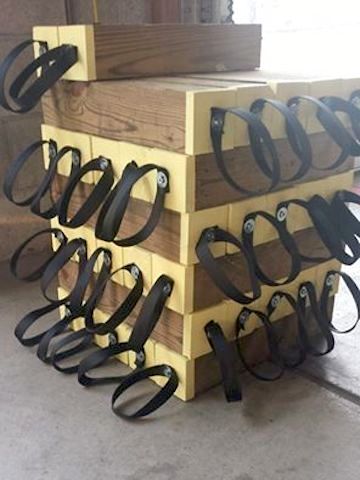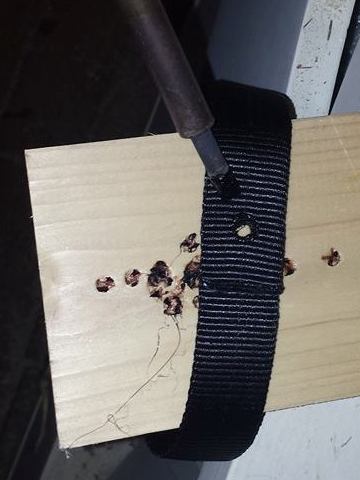Assist Chief. Dennis Baker Jr. from Baden (PA) sent in these pictures of how they set up their cribbing. He made sure to point out that Lt. Tim Firich was actually the one who should get the credit for the idea. They color-coded their cribbing based on length. The ones pictured happen to be 18†6×6’s. As you can see in the picture below the paint color actually goes about an inch onto the side of the cribbing as well. This little addition makes it easy to visually see from a distance that the cribbing tower is square.
The handles are 1 inch webbing cut at 16 inches long and secured with a fender washer and 1 1/4″ wood screw. They overlapped the webbing and used a soldering pencil to burn the whole for the screw. This will prevent the webbing from unraveling near the screw hole.
The idea of color-coding could be implemented a few different ways: either length or lumber size. Even wedges could be coded with different color paint, or even a different color of webbing. For example if you painted your 4×4’s red, the 4×4 wedges could also be red, but with a different color webbing. The important thing is not of over think it. Come up with a standardized marking system that works for you and your agency.



Our tower has been using different colored webbing for a while now and it works out well. I will bring up the idea of painting as well, though either way it makes it much easier to grab what you want with relative ease.
This one time, I saw Jimm talk about fire stuff in Baden, PA.
yep,,,,We too use differant color webbing its so much easeir than painting… Red=4×4, black=2x material,
blue=wedges, and orange=6x
We’re Idiots…. We’ve been drilling through the webbing, spinning it around the drill and having it unravel for years…..(seriously, we have) No Longer!!!! Love me some VES.com
We have always color coded our cribbing and most of our neighbors followed suit. We then went a step further and branded the ends of our cribbing with UFC (United Fire Co) to identify our cribbing from mutual aid companies at multi-department incidents and training